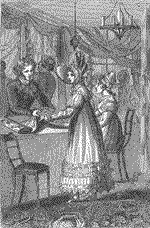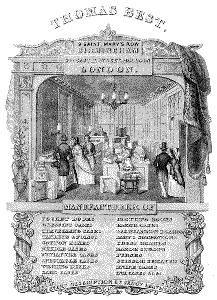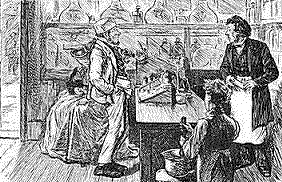Shopping was considered a part of the woman's job in the keeping of the home and her husband worked to create the private world of the "stay at home" wife. Working class women, however, had a "second shift" as upon returning home from work, often had to clean the house and cook for her family.
The majority of shops were owned by men although some were owned by women or the widow of a shop owner. Women were not permitted to own property or sign contracts earlier in the period. It was also believed at the time that women should not be merchants as they lacked the brains, stamina and competitive drive that was required to run a business.1 Examples of shops that were run by women were milliners, seamstresses and dressmakers. Some also were street sellers who walked around selling items from baskets or worked at shop stalls selling goods they purchased wholesale or made themselves.
Early in the period goods did not have prices on them. One had to ask how much it cost, which did allow some room for haggling. It also gave the shopkeeper the ability to charge a higher price to a shopper who looked more affluent than another or to lower a price in order to gain a sale. Also one was not allowed to "touch" the goods without the shop's clerk. All goods were kept in drawers, cases or behind the counter out of the shopper's reach.
The above began to change in the 1830s. More and more shop owners began placing items on counters and shelves with prices noted. The stores began to expand in size and with the installation of plate glass windows became brighter along with displays of merchandise placed within them; their "shutters" being removed in the morning for the start of business and put back up at dusk at the shop's closing.
Shopping became a popular activity later in the century, with women being the majority of the shoppers. Society looked upon shopping as falling in the realm of the middle-class woman's responsibilities, yet criticized them for wasting time in the shops, for being idle, lazy and selfish and obsessed with trivial things such as the color of a ribbon. When it came to men shopping, they did for some of their own things; however, were quite happy to let their wives and daughters shop for them the majority of the time. The male shopper's image contrasted to a woman's in that he appeared to be disinterested and anxious.
 The stores would open as early as 6:00 A.M. in the summer and 8:00 A.M. in the winter. In the mornings, the majority of the shoppers were servants with an influx of middle-class women late morning. The shopping trip would usually last a full day with the shopper returning home before sunset despite shops remaining opening later into the evening.
The stores would open as early as 6:00 A.M. in the summer and 8:00 A.M. in the winter. In the mornings, the majority of the shoppers were servants with an influx of middle-class women late morning. The shopping trip would usually last a full day with the shopper returning home before sunset despite shops remaining opening later into the evening.
The shops themselves were small and could be dark and badly ventilated or bright and elaborately decorated and arranged and shops existed for every "social class". The layouts were similar, however, and typically featured a "glass door or window", a lighted counter area and racks behind the counter filled with merchandise and a staff to attend to customers. As the century progressed and the stores got larger, employees called "shop walkers" were hired who were a cross between a "security guard and personal shopping assistant.
 Shops in the 19th century differed from those today in their uniqueness. There were small shop and there were large shops. They had different suppliers and
different inventories and were willing to take a chance on untested products. And the larger department stores featured marble decorated rest rooms and a restaurant. Women's clothes were also placed on the 2nd floor as to avoid a male shopper from waling into an embarrassing situation. The stores also featured on-site tailors for customizing newly purchased clothing.
Shops in the 19th century differed from those today in their uniqueness. There were small shop and there were large shops. They had different suppliers and
different inventories and were willing to take a chance on untested products. And the larger department stores featured marble decorated rest rooms and a restaurant. Women's clothes were also placed on the 2nd floor as to avoid a male shopper from waling into an embarrassing situation. The stores also featured on-site tailors for customizing newly purchased clothing.
Early in the period, the shop's staff which totaled approximately 6 consisted of the owner and other members of his family and might have included an apprentice. The typical work week was Monday through Saturday plus a half-day on Sunday. Christian reformers during the period called for the ending of business on Sunday and while this posed no problem for the middle and upper classes, it did add to a degree some pressure on the working class as all their shopping had to be done on Saturday.
 Shopping was not all pleasure as there were dangers to deal with in the marketplace with thieves, pickpockets and others who made their living preying on shoppers. Shoplifting increased and surprisingly a fairly large number of arrests were of well-dressed middle-class women who were tempted by the goods accessibility.
Shopping was not all pleasure as there were dangers to deal with in the marketplace with thieves, pickpockets and others who made their living preying on shoppers. Shoplifting increased and surprisingly a fairly large number of arrests were of well-dressed middle-class women who were tempted by the goods accessibility.
Young saleswomen were also affected being approached with unwanted sexual advances from male shoppers. It was believed that if a young woman worked in a shop she must be "available" as their wages were extremely low and they would be looking for additional ways to increase their income.
There were other dangers that existed as well, the toxicity of certain chemicals used in the manufacture of goods and consumers feeling that the shopkeeper might be trying to cheat them. In a study by Henry Mayhew in 1851, a number of frauds and scams were identified throughout London. In one scheme, goods were being marketed as "smuggled and stolen" as it was thought that it would add to their appeal. Other scams included letters soliciting funds for investments or charity (and we thought this was a 20th century concept). Counterfeit money, adulterated foods and other tricks also existed in the marketplace.
In order to protect themselves, shoppers very often frequented the same stores and built relationships with the shopkeepers. Products were becoming available prepackaged by the manufacturer reducing the risk of adulteration and short weight. Royal warrants were also created which permitted the tradesman to have a coat of arms applied to their stationery as a sign of quality of their products. Queen Victoria and her family granted over 2000 such warrants during her reign.1
Back to Intro/Index or Site Map
| | Family Gallery | Servants Parlour | Tour Home | Typical Day | Etiquette | Shopping Trip | |
| | Victorian Christmas | Victorian England Fun and Games | Ashton Library | Victorian Wedding | |
| | Victorian England Overview | Guest Registry | Honorary Victorian | Tours | |
| | Awards Received | Bibliography | |
| | 1876 Victorian England Home | |
Credits below copyright information |
| Contact
webmaster |
| Copyright
1999-2017 All Rights Reserved - B. Malheiro May not be reproduced in any way without express written permission of webmaster. |
Credits:
Background and buttons are the creation of webmaster, B. Malheiro. These images have been watermarked and are not for use on another site. Site authored by webmaster.